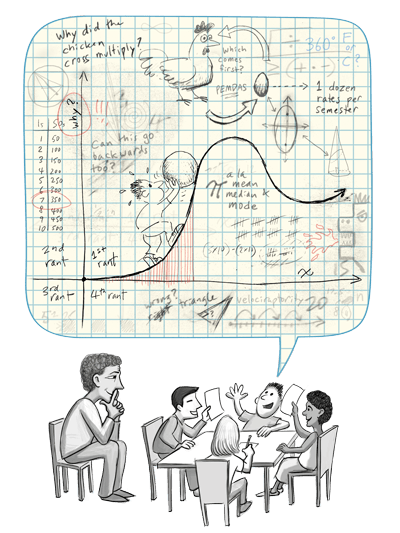6th and 7th Grade Lessons for Diagnostic Teaching in Mathematics
Assessment tools such as quizzes and exit tickets can only go so far. When teachers become skilled at managing the classroom and in providing motivating activities for students, we see that they often aspire to reach the next level: diagnostic teaching.
The Basics of Diagnostic Teaching
In diagnostic teaching, teachers focus thoughtfully on what students do and do not understand and then adjust accordingly. This can happen at various times during teaching:
Teachers often learn a great deal about student thinking during
classroom discussion.
When working in groups, students plan and communicate with each other about their work. This provides teachers opportunities to listen in and to learn how students are integrating concepts and skills.
During student presentations, student teams explain and ask questions about the work of their classmates. This is a valuable time for teachers to learn where understanding is solid and where it is tentative.
Teachers can also gauge understanding by asking students to relate multiple representations
to each other. The ability (or inability) to see relationships and to articulate the underpinnings of mathematical approaches offers teachers insights about how students are thinking about the mathematics.
Analyze Student Thinking in Real Time
Mathematics lessons from typical textbooks often are not designed so that the thinking of the students is surfaced and open for teacher analysis in real time. Therefore, we developed a six-phase system to work through an engaging problem over two days. All of the Poster Problems are aligned with the Common Core State Standards in Mathematics.
Strategic Math Problems
The 12 problems available here are designed to shed light and to contextualize a math topic crucial to the sixth- and seventh-grade levels. The approaches students will use with these problems should vary, ranging from below grade-level mathematics up to grade-level mathematics (or beyond!). This provides teachers an ideal opportunity to link multiple representations as they strategically lead students in discussions about the mathematics.
Project funding provided by The William and Flora Hewlett Foundation and S.D. Bechtel Jr. Foundation.
This work is licensed under a Creative Commons Attribution-NonCommercial-ShareAlike 4.0 International License.




